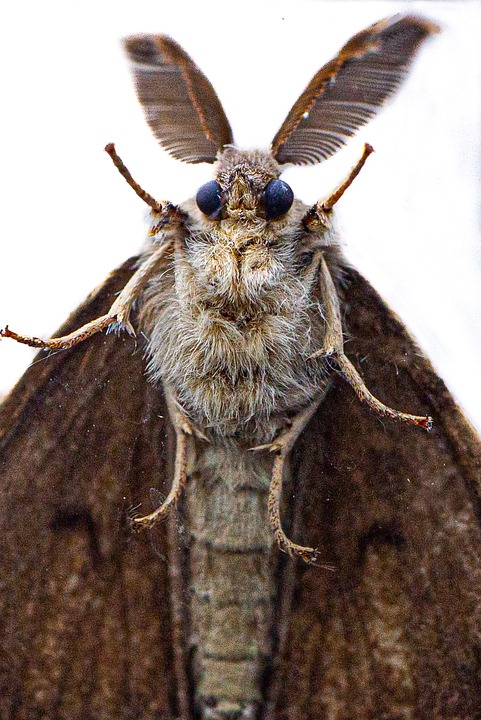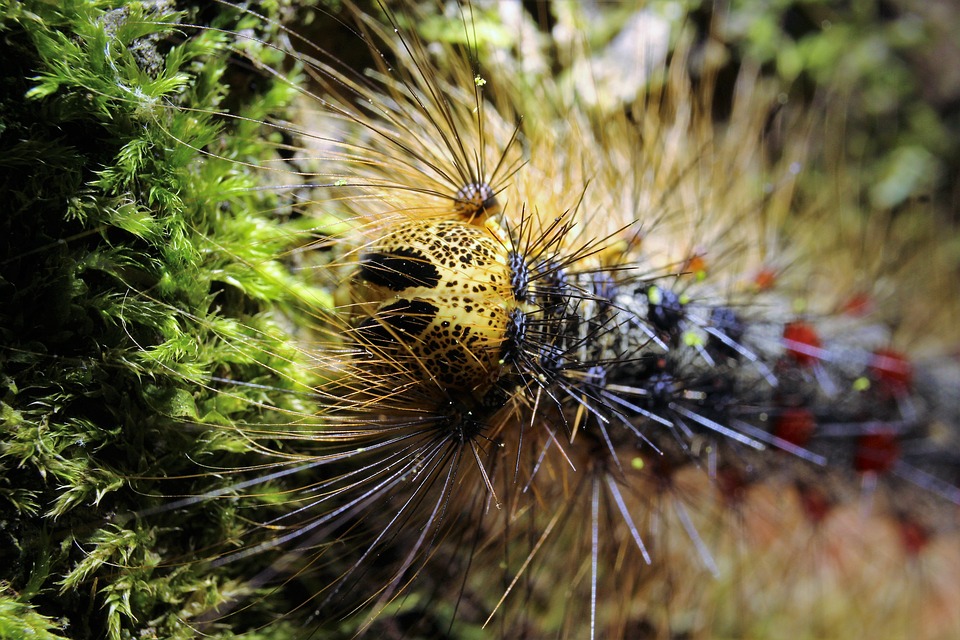Many people were dismayed by the devastation these caterpillars caused last year. In this guest article by Harvest Hastings member Stefan Dixon of Willows Green Permaculture, Stefan explains how natural methods could control future infestations and expresses his concerns about the use of aerial spraying of Btk pesticides.
This past January 15th, I received an unsettling waiver in my mailbox from my neighbour. It proposed the aerial spraying of their property (via helicopter, I later found out) with Btk, in order to eradicate the LDD (Gypsy) moth. Btk, however, is a generalist pesticide: that is, it is fatal to all native caterpillars in the Lepidoptera family that eat it (and they will). It does not, and cannot, target only the LDD moth. All food growers rely on a great many native caterpillar species for pollination when they reach adult butterfly/moth stage, for the food that they grow. More on this below.
Upon doing some research about this spray programme, I learned that it was actually proposed and publicized by the City of Quinte West in the local Community Press newspaper that is delivered automatically to all residents. Their proposal can also be found on their website at the following link: https://quintewest.ca/water-environment/ldd-moths/
When I accessed the above link, I found that the City of Quinte West is asking constituents to consider hiring a private company (which is named in the add) to spray their property with Btk. It does not mention, however, that this spray programme would be done aerially, via helicopter. There was also no effort made to ensure that all citizens would learn about this pesticide spray programme. Public input should have been part of the process considering that this programme is a radical departure from a couple of decades of practice of outlawing generalist pesticide use by private citizens. Had I not received the waiver from my neighbour in my mailbox, I would not have known. I am not in the practice of reading the Community Press from cover to cover every time it arrives, and I am certainly not in thepractice of combing the City’s website everyday to see what is going on at City Hall. I was, to say the least, shocked at learning all of this.
I submit that there is no need to attempt to eradicate the LDD moth with a potential extremely damaging pesticide spray programme, and this, for several reasons. Below I will explain why, from the viewpoint of someone who relies on the very plants and trees that the LDD moth often devours.
For context, we, at Willows Green Permaculture, grow 90% of the food we eat year-round, on less than 1 tenth of an acre (400 square metres – an area equivalent to a square with 65 feet on each side – about 4000 square feet). We rely on a healthy, biodiverse environment for the food we grow, as do all food growers.
Last year, when the LDD moths were out in huge numbers, our food production was unaffected. We received many comments from neighbours and passersby about the vibrancy of our garden out front. They wondered about the LDD moths and asked about them. We were able to tell them that they didn’t damage our trees and shrubs. They asked us how that was possible. It is possible because of our methods of growing our food:
- We take advantage of biodiversity on our entire property and in our vegetable garden in particular. In the garden, for example, in any given square metre, you will find several species, thus making it more difficult for pest species to find their host plant and to thrive.
- We do companion planting. There are groups of plants that like to be planted in close proximity to each other because they benefit each other in different ways. Each may repel the pests of the other plant and vice versa, or provide some kind of natural molecule that they release into the air or into the earth that the other plant thrives on. The relationship may also depend on the relative size and shape of each plant. There are many possible factors.
- We imitate nature in how we garden and in how we take care of our entire property.
- We set up habitat in and around our garden to attract the native species that will help us with our gardening. For example…
o Logs surrounding our garden, as well as a raingarden next to it, attract and provide shelter to frogs and toads, which help us with the insects and slugs in our garden.
o Native flowers, herbs and shrubs provide food and shelter for birds and insects which help us with pollination and, once again, with the control of pest insects.
o Certain of the species we grow are also disliked by deer so we surround our garden with them, thus keeping the deer away from our vegetables.
o We plant species that deer enjoy feeding on far away from our garden in areas where we see that they forage and sometimes sleep. We often see that deer have even slept on our property, and yet they leave our vegetable garden alone.
o We use mulch (woodchips or straw) to keep our plant roots protected, hydrated and happy, and to keep the unwanted plants down. These are also used by frogs and toads for shelter. The mulch, depending on the kind, also sets up the soil habitat with the mycelial or bacterial networks that will best support the root life of and healthy soil life around the plants.
Knowing how nature works, respecting nature, working with nature and using nature as a guide is key to having healthy soil, a healthy environment and therefore healthy trees, shrubs, crops and gardens. Pesticides and herbicides only kill. They kill insects and often the animals that feed on them, they destroy the soil and render it infertile and, ultimately, they kill us.
For all of the reasons explained above and many more, we were unaffected by the LDD moth last year. However, if the city blanket sprays its properties with Btk, and countless neighbours across the county spray their properties as well, this will decimate the populations of all native butterflies and moths (and not just the non-native LDD moth). Proponents will try to claim that other species of caterpillar (the native ones) feed at other times or in other places. This is not true. In our area, as in others, all of the caterpillars come out at generally the same time. Furthermore, in a given place, you have many microhabitats with many different native species. It is impossible to spray in areas where you will have only gypsy moths. Anyone who tries to tell you this has no idea how nature works, is lying or is willfully ignorant. It is important to be clear: Btk does not target only the LDD moth. Monarchs, for example, are just one of the hundreds of native butterflies and moths which will perish when their caterpillar eats the Btk. This will affect the ecosystem in many ways. Pollination rates will plummet when a significant portion of the pollinator population is gone. This will affect food production, whether this be in your backyard garden or on a farm. This will also affect pollination in the wild, thus reducing the health of the whole ecosystem. Also, birds, amphibians, reptiles and other animals which depend on the native butterflies and moths for their survival will be weakened. For example, native birds will have little to give their nestlings at this crucial point in their development. The whole ecosystem will be severally affected. The damage that will be caused to the ecosystem by the blanket aerial spraying of Btk, as proposed and adopted by the City of Quinte West, will do much more damage than the LDD moths that it is attempting to eradicate.
There is no need for this damage to the ecosystem.
As explained above, holistic gardening practices which take into account the vast knowledge we have gained in recent decades about how to maintain balance in the ecosystem, through biodiversity and through practices which respect the central place the environment holds in life on our planet, are sufficient to keep the gypsy moth at bay. Plants, trees and shrubs that are resilient and healthy, in a resilient and healthy ecosystem, will thrive and be unaffected by the LDD moth. If plants in our area have died due to the LDD moth, it is because they were already unhealthy or there was already a lack of balance and health in the local microclimate around the affected plants. This is not surprising considering that our society still has a long way to go before the entire society espouses practices that respect nature and adopt nature as a guide. The solution is to add resiliency to the local ecosystems, not poison them and knock them out of balance.
In addition to the above points, this past month, across our region, we have had a much colder winter than what we have had in recent years. The warm winters we had last year and the year before contributed a great deal to the numbers of LDD moths. This year, however, the cold weather we have had should go a long way in killing many of them off. I have also read about a great deal of natural viral kill-off of LDD moths toward the end of the season last year due to the great numbers of LDD moths that there were. We should not see the same numbers of LDD moths in the summer of 2022. If we do, however, the practices I have described above can greatly mitigate the potential damage.
The City of Quinte West talks about protecting its tree canopy through the use of this spray. In fact, as explained above, healthy trees are unaffected by the LDD moth. They lose leaves temporarily and then bounce back. Therefore, there is no need to use this spray to protect the tree canopy of Quinte West. It should be noted that Quinte Conservation and Lower Trent Conservation both decided against the use of Btk on their properties. As they are Conservation Authorities, whose main concern is to conserve and protect the environment, they have a particular expertise in making such a decision, more so, I might suggest, than city councillors who are understandably trying to make their rightly worried constituents happy. The answer to the problem that the City of Quinte West has at its disposal, however, is all around them. There are a great many people from across the region, whose activities you can find in the Harvest Hastings publication, who are already living examples of how we can live in harmony with nature and deal with unwanted potential damage from a non-native invasive species such as the LDD moth.
I have formally requested to appear before Quinte West City Council under public input in order to let council know about the concerns of our community. If you are interested in appearing with me, please contact me through Harvest Hastings at Willows Green Permaculture | Harvest Hastings. I would be delighted to be accompanied and to have additional expertise and experience added to the effort.
If you have any questions or would like further details about how to set up a productive and biodiverse habitat on your property that allows you to enjoy the outdoors, to enjoy nature and native wildlife and to produce your own healthy, nutrient dense, natural and organic food, do not hesitate to contact me at Willows Green Permaculture. You can find my site and contact information on the Harvest Hastings website at Willows Green Permaculture | Harvest Hastings

Notes:
https://quintewest.civicweb.net/document/87038
Minutes of December 6th meeting.
I see no pros and cons discussed in these minutes.
You can find the advertisement in which the City of Quinte West is asking the public for help in combatting the LDD moth on page 11 of The Community Press newspaper, in the January 27th and February 3rd 2022 editions. In this advertisement, they ask the public to visit the following website: nhttps://quintewest.ca/water-environment/ldd-moths/ . At this site, among other things, they ask citizens to consider booking the Ontario Centre for Forest Defoliator Control (OCFDC) to do the spraying. In italics, they say citizens should reserve as soon as possible. If you go on the OCFDC site, you further find out that the spraying will be aerial, via helicopter.
There is a great deal of research available on the internet about everything I have discussed in this article, and I can provide links to this as well, if so desired.
Stefan Dixon
Willows Green Permaculture
Stirling, Ontario



